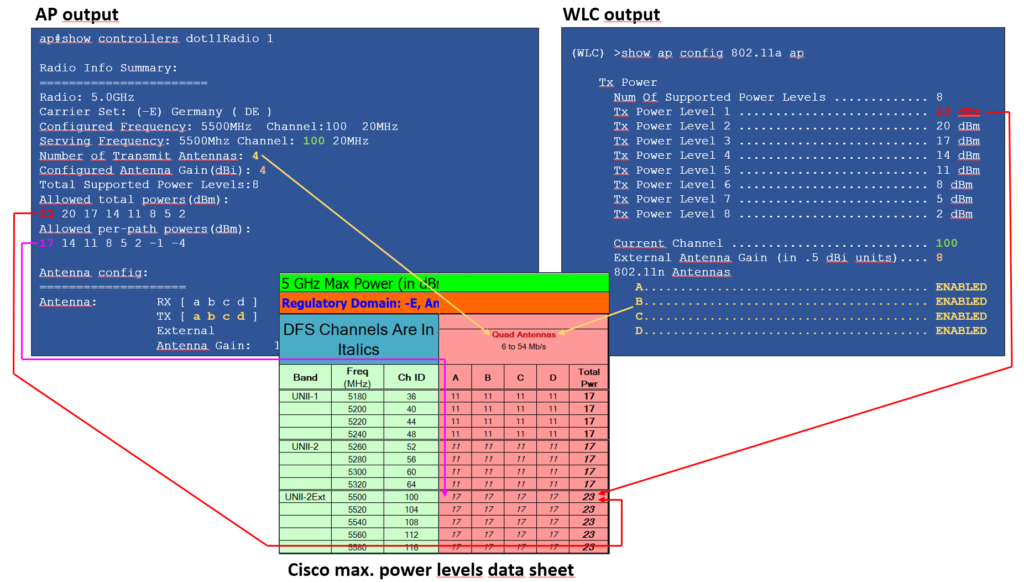WLAN power levels are easy, right? In Europe you “know”, that the maximum WLAN transmit power is 100 mW (20 dBm). However, this is true for the 2,4 GHz band and the limit describes the EIRP (equivalent isotropically radiated power).
This means, if there is a regulatory limit of 100 mW (20 dBm), the maximum power you are allowed to configure on the AP, depends on the antenna you are using, because the antenna gain must be included in the calculation as well:
TX(AP_max) = RegulatoryLimit – AntennaGain
For example: If an antenna with 3 dBi is used, the max. TX power on the AP side (for the 2,4 GHz band) is 17 dBm (TX(AP_max) = 20 dBm – 3dB).
Easy, right?
However, it becomes more complicated for the 5 GHz band, because it depends on the band (channel) you are using and on the 802.11h (DFC and TPC) capabilities. I illustrated the regulatory limit for Europe / ETSI in the following figure:
Today, the WLAN equipment is typically DFS and TPC capable, to use may use the channels 36 – 140 in Europe. The channels 120, 124 and 128 are grayed out, because Cisco left them out, because there is critical radar (aviation, weather) equipment on these channels.
A little bit more complex, but still easy, right?
However (sigh), this is still not the complete picture. The regulatory limits must be met, if multiple TX antennas send at the same time (MIMO).
This means in theory (caution: result is in mW – input in dB)
For example: The AP transmits on channel 36 (Europe) using two spatial streams without beamforming (802.11n MCS index 8 – 15):

Using the same example from above, the result is 33mW (~15dBm) for three TX antennas and 25mW (~14dBm) using four antennas.
So in fact, for SISO client the max TX power per stream is higher compared to a MIMO client using multiple streams and beamforming.
Caution: If a client is using three streams and additionally ClientLink (beamforming) is used, four transmit antennas are used in total!
Easy, somehow … whatever 🙂
So what is the take home message until now? The TX power per antenna is different and depends on:
- Number of TX antennas (spatial streams, beamforming)
- Regulatory limit
- Antenna gain
However, the Cisco WLC and the APs only displays ONE TX power value per power level, as illustrated in the output below (example for an 2802i AP):
(Controller) >show ap config 802.11a <AP-NAME>
[…] output omitted
Tx Power
Num Of Supported Power Levels ............. 8
Tx Power Level 1 .......................... 23 dBm
Tx Power Level 2 .......................... 20 dBm
Tx Power Level 3 .......................... 17 dBm
Tx Power Level 4 .......................... 14 dBm
Tx Power Level 5 .......................... 11 dBm
Tx Power Level 6 .......................... 8 dBm
Tx Power Level 7 .......................... 5 dBm
Tx Power Level 8 .......................... 2 dBm
Tx Power Configuration .................... AUTOMATIC
Current Tx Power Level .................... 5
Tx Power Assigned By ...................... CHDM
Phy OFDM parameters
Configuration ............................. CUSTOMIZED
Current Channel ........................... 100
[...]
802.11n Antennas
A....................................... ENABLED
B....................................... ENABLED
C....................................... ENABLED
D....................................... ENABLED
On channel 100, the max TX power (power level 1) is 23 dBm if four antennas are active. The AP offers a more detailed output:
ap#show controllers dot11Radio 1
Radio Info Summary:
=======================
Radio: 5.0GHz
Carrier Set: (-E) Germany ( DE )
Configured Frequency: 5500MHz Channel:100 20MHz
Serving Frequency: 5500Mhz Channel: 100 20MHz
Number of Transmit Antennas: 4
Configured Antenna Gain(dBi): 4
Total Supported Power Levels:8
Allowed total powers(dBm):
23 20 17 14 11 8 5 2
Allowed per-path powers(dBm):
17 14 11 8 5 2 -1 -4
Antenna config:
====================
Antenna: RX [ a b c d ]
TX [ a b c d ]
External
Antenna Gain: 1. 4dBi 2. 4dBi 3. 4dBi 4. 4dBi
The total power (allowed total powers) matches the WLC output (23 dBm). However, the TX power per antenna is 17 dBm. This means:
If a frame is sent to a MIMO client with three spatial streams and beamforming, the total TX power is 23 dBm (17 dBm * 4). The EIRP per antenna is ~22 dBm (158mW). The total EIRP for all antennas is ~28 dBm (631mW).
If a frame is sent to a SISO (legacy 802.11a) client with one stream, the total TX power is 17 dBm (17 dBm * 1). The EIRP per antenna (and total) is ~21 dBm (125mW).
Here’s a summary how the outputs of the AP, the WLC and the “channels and maximum power level” sheet from Cisco correlate (2802i example):
Note: The power level, which defines the cell size is the power level for the single stream. Beacon frames are sent at the lowest mandatory/basic data rate, which is typically a legacy 802.11a/b/g data rate. These frames are always transmitted using ONE antenna.





0 Comments